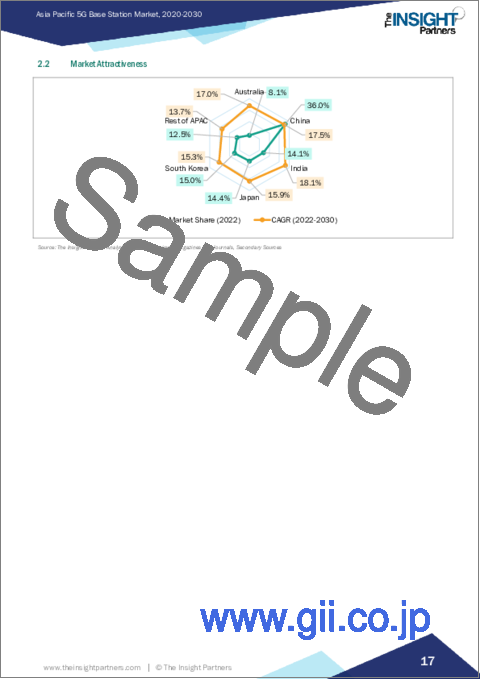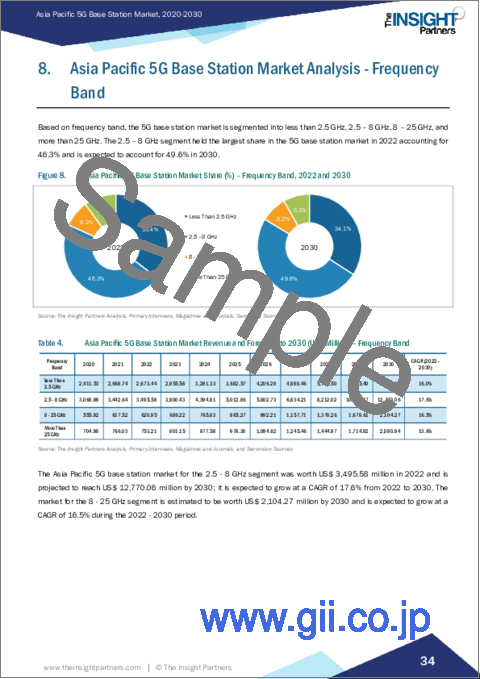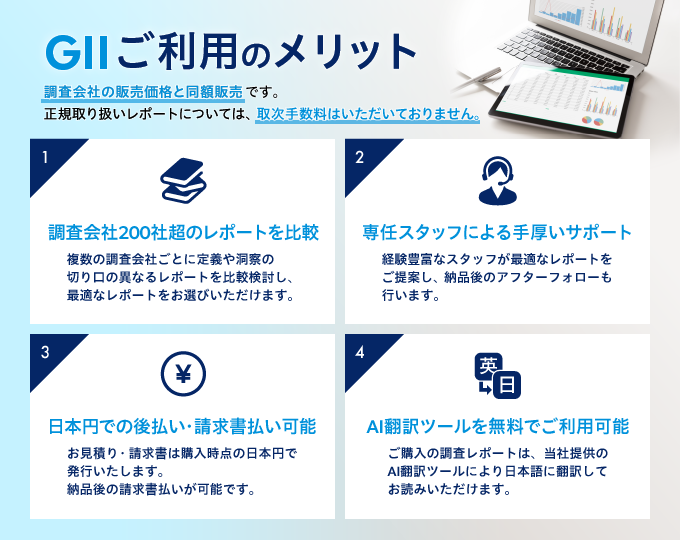|
|
市場調査レポート
商品コード
1533095
アジア太平洋の5G基地局市場予測(~2030年):地域別分析 - コンポーネント別、周波数帯域別、セルタイプ別、エンドユーザー別Asia Pacific 5G Base Station Market Forecast to 2030 - Regional Analysis - by Component, Frequency Band, Cell Type, and End User |
||||||
|
|||||||
| アジア太平洋の5G基地局市場予測(~2030年):地域別分析 - コンポーネント別、周波数帯域別、セルタイプ別、エンドユーザー別 |
|
出版日: 2024年06月04日
発行: The Insight Partners
ページ情報: 英文 118 Pages
納期: 即納可能
|
全表示
- 概要
- 図表
- 目次
アジア太平洋の5G基地局市場は、2022年に75億4,319万米ドルとなり、2030年には257億4,356万米ドルに達すると予測され、2022年~2030年のCAGRは16.6%と推定されます。
新興諸国における5G加入の増加がアジア太平洋の5G基地局市場を押し上げる
インド、中国、マレーシアなどの新興諸国では、5Gの加入率が増加しています。エリクソンのレポートによると、インドは2023年第2四半期に約700万人のモバイル加入者を登録し、次いで中国が500万人となっています。中国は、デジタルサービス開発をサポートできる高速ブロードバンドプラットフォームを構築するため、5Gとファイバーブロードバンドネットワークの展開に非常に力を入れています。中国は2022年に5Gの普及率~60%を記録しました。チャイナ・モバイルは最大の5G事業者で、4億6,660万人の5G顧客を有し、5G顧客全体の約55%を占めています。また、チャイナ・テレコムの5G顧客は2億1,080万人で、国内の5G加入者市場の約25%を占め、チャイナ・ユニコムは1億7,070万人で、加入者全体の20%を超えています。さらに、2023年9月、マレーシアの大臣は、同国が合計5,873カ所の5Gサイトを完成させ、合計249万件の5G契約を獲得したことを明らかにしました。したがって、いくつかの新興諸国における5G加入率の増加は、予測期間中に5G基地局市場の成長にとって有利な機会を創出すると予想されます。
アジア太平洋の5G基地局市場概要
アジア太平洋における5G基地局の需要は増加傾向にあります。アジア太平洋には世界で最も人口の多い国がいくつかあり、スマートフォンの普及が急増しています。例えば、世界で最も人口の多い中国は、スマートフォンのユーザー数が膨大に増加しています。GSM協会によると、中国では2022年末までに13億人近くのユーザーがモバイルサービスに加入するといいます。2025年までに、中国は10億の5G接続を持つ最初の市場になると思われます。同国の5G接続は2030年までに16億に達し、世界全体のほぼ3分の1を占めます。2022年、モバイル・サービスとテクノロジーは中国のGDPの5.5%を生み出し、その貢献は1兆1,000億米ドルに達しました。さらに、この地域の各国政府は5Gインフラへの投資を進めています。例えば、2023年10月、インド首相はニューデリーのバーラト・マンダパムで第7回インド・モバイル・コングレス2023(IMC)を開幕させました。IMCはアジア太平洋最大の通信、メディア、技術フォーラムです。5Gラボ機器には、管理ダッシュボードとともに、ラボのニーズを満たす5G SAインフラ(ミッドバンド)、5G SIM、ドングル、IoTゲートウェイ、ルーター、アプリケーション・サーバーが含まれます。同様に、インドでは光ファイバー化と通信タワーの追加配備の必要性が高くなっています。Digital Infrastructure Providers Association(DI PA)は、インドの特定の州によるRight of Way(ROW)ルールの非遵守を強調しました。DIPAは、タワーの65%を光ファイバー化し、2023年~2024年の間に120万タワーを追加配備することの重要性を強調しました。このように、アジア太平洋における5G基地局の需要は、政府と通信会社の双方による5Gへの大規模な投資と展開により拡大しています。
アジア太平洋の5G基地局市場の収益と2030年までの予測(金額)
アジア太平洋の5G基地局市場セグメンテーション
アジア太平洋の5G基地局市場は、コンポーネント、周波数帯域、セルタイプ、エンドユーザー、国に分類されます。
コンポーネント別では、アジア太平洋の5G基地局市場はハードウェアとサービスに二分されます。2022年の市場シェアで大きかったのはハードウェアセグメントです。
周波数帯域では、アジア太平洋の5G基地局市場は2.5GHz未満、2.5~8GHz、8~25GHz、25GHz超に区分されます。2022年の市場シェアは2.5~8GHzが最大でした。
セルタイプ別に見ると、アジア太平洋の5G基地局市場はマクロセルとスモールセルに二分されます。2022年の市場シェアはスモールセルセグメントが大きいです。さらに、スモールセルセグメントはマイクロセル、ピコセル、フェムトセルに細分化されます。
エンドユーザー別に見ると、アジア太平洋の5G基地局市場は産業、商業、住宅に区分されます。2022年の市場シェアは商業セグメントが最大でした。
国別では、アジア太平洋の5G基地局市場は中国、オーストラリア、インド、日本、韓国、その他アジア太平洋に区分されます。2022年のアジア太平洋の5G基地局市場シェアは中国が独占しました。
Airspan Networks Holdings Inc、Alpha Networks Inc、Baicells Technologies North America Inc、Huawei Technologies Co Ltd、NEC Corp、Nokia Corp、Samsung Electronics Co Ltd、Telefonaktiebolaget LM Ericsson、ZTE Corpは、アジア太平洋の5G基地局市場で事業を展開する大手企業です。
目次
第1章 イントロダクション
第2章 エグゼクティブサマリー
- 主要洞察
- 市場の魅力
第3章 調査手法
- 調査範囲
- 2次調査
- 1次調査
第4章 アジア太平洋の5G基地局市場情勢
- エコシステム分析
- バリューチェーンのベンダー一覧
第5章 アジア太平洋の5G基地局市場:主要市場力学
- アジア太平洋の5G基地局市場:主要市場力学
- 市場促進要因
- 低遅延・高速データへの需要の高まり
- 5Gネットワーク開発における政府のイニシアティブの高まり
- IoTとインダストリー4.0の導入急増
- 市場抑制要因
- 5Gインフラの導入コストの高さ
- ネットワーク放射線に関する政府規制
- 市場機会
- スマートインフラとスマートシティの発展
- 新興諸国における5G契約の増加
- 今後の動向
- エッジコンピューティングの利用増加
- 促進要因と抑制要因の影響
第6章 5G基地局市場:アジア太平洋市場分析
- アジア太平洋の5G基地局市場の収益(2020年~2030年)
- アジア太平洋の5G基地局市場の予測と分析
第7章 アジア太平洋の5G基地局市場分析:コンポーネント
- ハードウェア
- ハードウェア市場:収益と2030年までの予測
- サービス
- サービス市場:収益と2030年までの予測
第8章 アジア太平洋の5G基地局市場分析:周波数帯域
- 2.5GHz未満
- 2.5GHz未満市場:収益と2030年までの予測
- 2.5~8 GHz
- 2.5~8GHz市場:収益と2030年までの予測
- 8~25GHz
- 8~25GHz市場:収益と2030年までの予測
- 25GHz超
- 25GHz超市場:収益と2030年までの予測
第9章 アジア太平洋の5G基地局市場分析:セルタイプ
- マクロセル
- マクロセル市場:収益と2030年までの予測
- スモールセル
- スモールセル市場:収益と2030年までの予測
- マイクロセル
- ピコセル
- フェムトセル
第10章 アジア太平洋の5G基地局市場分析:エンドユーザー
- 産業
- 産業市場:収益と2030年までの予測
- 商業
- 商業市場:収益と2030年までの予測
- 住宅市場
- 住宅市場:収益と2030年までの予測
第11章 アジア太平洋の5G基地局市場:国別分析
- アジア太平洋
- オーストラリア
- 中国
- インド
- 日本
- 韓国
- アジア太平洋のその他諸国
第12章 業界情勢
- 市場イニシアティブ
- 製品開発
- 合併・買収
第13章 企業プロファイル
- ZTE Corp
- Huawei Technologies Co Ltd
- NEC Corp
- Samsung Electronics Co Ltd
- Telefonaktiebolaget LM Ericsson
- Nokia Corp
- Airspan Networks Holdings Inc
- Alpha Networks Inc
- Baicells Technologies North America Inc
第14章 付録
List Of Tables
- Table 1. Asia Pacific 5G Base Station Market Segmentation
- Table 2. Asia Pacific 5G Base Station Market Revenue and Forecasts to 2030 (US$ Million)
- Table 3. Asia Pacific 5G Base Station Market Revenue and Forecasts to 2030 (US$ Million) - Component
- Table 4. Asia Pacific 5G Base Station Market Revenue and Forecasts to 2030 (US$ Million) - Frequency Band
- Table 5. Asia Pacific 5G Base Station Market Revenue and Forecasts to 2030 (US$ Million) - Cell Type
- Table 6. Asia Pacific 5G Base Station Market Revenue and Forecasts to 2030 (US$ Million) - Small Cell
- Table 7. 5G Base Station Market Revenue and Forecasts to 2030 (US$ Million) - End User
- Table 8. Asia Pacific 5G Base Station Market Revenue and Forecasts to 2030 (US$ Mn) - By Country
- Table 9. Australia 5G Base Station Market Revenue and Forecasts to 2030 (US$ Mn) - By Component
- Table 10. Australia 5G Base Station Market Revenue and Forecasts to 2030 (US$ Mn) - By Frequency Band
- Table 11. Australia 5G Base Station Market Revenue and Forecasts to 2030 (US$ Mn) - By Cell Type
- Table 12. Australia 5G Base Station Market Revenue and Forecasts to 2030 (US$ Mn) - By Small Cell
- Table 13. Australia 5G Base Station Market Revenue and Forecasts to 2030 (US$ Mn) - By End User
- Table 14. China 5G Base Station Market Revenue and Forecasts to 2030 (US$ Mn) - By Component
- Table 15. China 5G Base Station Market Revenue and Forecasts to 2030 (US$ Mn) - By Frequency Band
- Table 16. China 5G Base Station Market Revenue and Forecasts to 2030 (US$ Mn) - By Cell Type
- Table 17. China 5G Base Station Market Revenue and Forecasts to 2030 (US$ Mn) - By Small Cell
- Table 18. China 5G Base Station Market Revenue and Forecasts to 2030 (US$ Mn) - By End User
- Table 19. India 5G Base Station Market Revenue and Forecasts to 2030 (US$ Mn) - By Component
- Table 20. India 5G Base Station Market Revenue and Forecasts to 2030 (US$ Mn) - By Frequency Band
- Table 21. India 5G Base Station Market Revenue and Forecasts to 2030 (US$ Mn) - By Cell Type
- Table 22. India 5G Base Station Market Revenue and Forecasts to 2030 (US$ Mn) - By Small Cell
- Table 23. India 5G Base Station Market Revenue and Forecasts to 2030 (US$ Mn) - By End User
- Table 24. Japan 5G Base Station Market Revenue and Forecasts to 2030 (US$ Mn) - By Component
- Table 25. Japan 5G Base Station Market Revenue and Forecasts to 2030 (US$ Mn) - By Frequency Band
- Table 26. Japan 5G Base Station Market Revenue and Forecasts to 2030 (US$ Mn) - By Cell Type
- Table 27. Japan 5G Base Station Market Revenue and Forecasts to 2030 (US$ Mn) - By Small Cell
- Table 28. Japan 5G Base Station Market Revenue and Forecasts to 2030 (US$ Mn) - By End User
- Table 29. South Korea 5G Base Station Market Revenue and Forecasts to 2030 (US$ Mn) - By Component
- Table 30. South Korea 5G Base Station Market Revenue and Forecasts to 2030 (US$ Mn) - By Frequency Band
- Table 31. South Korea 5G Base Station Market Revenue and Forecasts to 2030 (US$ Mn) - By Cell Type
- Table 32. South Korea 5G Base Station Market Revenue and Forecasts to 2030 (US$ Mn) - By Small Cell
- Table 33. South Korea 5G Base Station Market Revenue and Forecasts to 2030 (US$ Mn) - By End User
- Table 34. Rest of APAC 5G Base Station Market Revenue and Forecasts to 2030 (US$ Mn) - By Component
- Table 35. Rest of APAC 5G Base Station Market Revenue and Forecasts to 2030 (US$ Mn) - By Frequency Band
- Table 36. Rest of APAC 5G Base Station Market Revenue and Forecasts to 2030 (US$ Mn) - By Cell Type
- Table 37. Rest of APAC 5G Base Station Market Revenue and Forecasts to 2030 (US$ Mn) - By Small Cell
- Table 38. Rest of APAC 5G Base Station Market Revenue and Forecasts to 2030 (US$ Mn) - By End User
- Table 39. List of Abbreviation
List Of Figures
- Figure 1. Asia Pacific 5G Base Station Market Segmentation, By Country
- Figure 2. Ecosystem: 5G Base Station Market
- Figure 3. Impact Analysis of Drivers and Restraints
- Figure 4. Asia Pacific 5G Base Station Market Revenue (US$ Million), 2020 - 2030
- Figure 5. Asia Pacific 5G Base Station Market Share (%) - Component, 2022 and 2030
- Figure 6. Hardware Market Revenue and Forecasts to 2030 (US$ Million)
- Figure 7. Service Market Revenue and Forecasts to 2030 (US$ Million)
- Figure 8. Asia Pacific 5G Base Station Market Share (%) - Frequency Band, 2022 and 2030
- Figure 9. Less Than 2.5 GHz Market Revenue and Forecasts to 2030 (US$ Million)
- Figure 10. 2.5 - 8 GHz Market Revenue and Forecasts to 2030 (US$ Million)
- Figure 11. 8 - 25 GHz Market Revenue and Forecasts to 2030 (US$ Million)
- Figure 12. More Than 25 GHz Market Revenue and Forecasts to 2030 (US$ Million)
- Figure 13. Asia Pacific 5G Base Station Market Share (%) - Cell Type, 2022 and 2030
- Figure 14. Macrocell Market Revenue and Forecasts to 2030 (US$ Million)
- Figure 15. Small Cell Market Revenue and Forecasts to 2030 (US$ Million)
- Figure 16. Microcell Market Revenue and Forecasts to 2030 (US$ Million)
- Figure 17. Picocell Market Revenue and Forecasts to 2030 (US$ Million)
- Figure 18. Femtocell Market Revenue and Forecasts to 2030 (US$ Million)
- Figure 19. 5G Base Station Market Share (%) - End User, 2022 and 2030
- Figure 20. Industrial Market Revenue and Forecasts to 2030 (US$ Million)
- Figure 21. Commercial Market Revenue and Forecasts to 2030 (US$ Million)
- Figure 22. Residential Market Revenue and Forecasts to 2030 (US$ Million)
- Figure 23. Asia Pacific 5G Base Station Market, by Key Country - Revenue (2022) (US$ Million)
- Figure 24. Asia Pacific 5G Base Station Market Breakdown by Key Countries, 2022 and 2030 (%)
- Figure 25. Australia 5G Base Station Market Revenue and Forecasts to 2030 (US$ Mn)
- Figure 26. China 5G Base Station Market Revenue and Forecasts to 2030 (US$ Mn)
- Figure 27. India 5G Base Station Market Revenue and Forecasts to 2030 (US$ Mn)
- Figure 28. Japan 5G Base Station Market Revenue and Forecasts to 2030 (US$ Mn)
- Figure 29. South Korea 5G Base Station Market Revenue and Forecasts to 2030 (US$ Mn)
- Figure 30. Rest of APAC 5G Base Station Market Revenue and Forecasts to 2030 (US$ Mn)
The Asia Pacific 5G base station market was valued at US$ 7,543.19 million in 2022 and is expected to reach US$ 25,743.56 million by 2030; it is estimated to register a CAGR of 16.6% from 2022 to 2030.
Increasing 5G Subscriptions in Developing Countries Boost Asia Pacific 5G Base Station Market
The rate of 5G subscriptions is increasing in developing countries such as India, China, and Malaysia. According to the report of Ericsson company, India registered approximately seven million mobile subscribers during the second quarter of 2023, followed by China with five million. China has been highly focused on 5G and fiber broadband network rollouts in an effort to build a high-speed broadband platform that can support digital service developments. China recorded a 5G penetration rate of ~60% in 2022. China Mobile is the largest 5G operator, with 466.6 million 5G customers, nearly 55% of the total 5G customers. Also, China Telecom had 210.8 million 5G customers, about 25% of the country's 5G subscriber market, while China Unicom had 170.7 million, over 20% of the total subscribers. Furthermore, in September 2023, the Minister of Malaysia disclosed that the country had completed a total of 5,873 5G sites, with a total of 2.49 million 5G subscriptions. Therefore, the increasing rate of 5G subscriptions in several developing countries is anticipated to create lucrative opportunities for the 5G base station market growth during the forecast period.
Asia Pacific 5G Base Station Market Overview
The demand for 5G base stations in Asia Pacific (APAC) has been on the rise. APAC is home to a few of the world's most populous countries, and there has been a surge in smartphone adoption. For example, China, the world's most populous country, has a massive and growing smartphone user base. According to the GSM Association, nearly 1.3 billion users in China subscribed to a mobile service by the end of 2022. By 2025, China will be the first market with 1 billion 5G connections. 5G connections in the country will reach 1.6 billion by 2030, accounting for almost a third of the global total. In 2022, mobile services and technologies generated 5.5% of China's GDP-a contribution that amounted to US$ 1.1 trillion. Furthermore, governments of various countries across the region are investing in 5G infrastructure. For instance, in October 2023, the Prime Minister of India inaugurated the 7th Edition of the India Mobile Congress 2023 (IMC) at Bharat Mandapam in New Delhi. IMC is the largest telecom, media, and technology forum in APAC. The 5G lab equipment would include 5G SA infrastructure (mid-band), 5G SIMs, dongles, IoT gateway, router, and application server to meet lab needs, along with a management dashboard. Similarly, there is a significant need for fiberization and additional telecom tower deployment in India. The Digital Infrastructure Providers Association (DI PA) highlighted non-compliance with Right of Way (ROW) rules by certain Indian states. DIPA stressed the importance of fiberization for 65% of towers and the deployment of an additional 1,200,000 towers between 2023 and 2024. Thus, the demand for 5G base stations in APAC is growing due to significant investments and deployments of 5G by both governments and telecommunications companies.
Asia Pacific 5G Base Station Market Revenue and Forecast to 2030 (US$ Million)
Asia Pacific 5G Base Station Market Segmentation
The Asia Pacific 5G base station market is categorized into component, frequency band, cell type, end user, and country.
Based on component, the Asia Pacific 5G base station market is bifurcated into hardware and service. The hardware segment held a larger market share in 2022.
In terms of frequency band, the Asia Pacific 5G base station market is segmented into less than 2.5 GHz, 2.5 - 8 GHz, 8 - 25 GHz, and more than 25 GHz. The 2.5 - 8 GHz segment held the largest market share in 2022.
By cell type, the Asia Pacific 5G base station market is bifurcated into macrocell and small cell. The small cell segment held a larger market share in 2022. Furthermore, the small cell segment is subsegmented into microcell, picocell, and femtocell.
Based on end user, the Asia Pacific 5G base station market is segmented into industrial, commercial, and residential. The commercial segment held the largest market share in 2022.
By country, the Asia Pacific 5G base station market is segmented into China, Australia, India, Japan, South Korea, and the Rest of Asia Pacific. China dominated the Asia Pacific 5G base station market share in 2022.
Airspan Networks Holdings Inc, Alpha Networks Inc, Baicells Technologies North America Inc, Huawei Technologies Co Ltd, NEC Corp, Nokia Corp, Samsung Electronics Co Ltd, Telefonaktiebolaget LM Ericsson, and ZTE Corp are among the leading companies operating in the Asia Pacific 5G base station market.
Table Of Contents
1. Introduction
- 1.1 The Insight Partners Research Report Guidance
- 1.2 Market Segmentation
2. Executive Summary
- 2.1 Key Insights
- 2.2 Market Attractiveness
3. Research Methodology
- 3.1 Coverage
- 3.2 Secondary Research
- 3.3 Primary Research
4. Asia Pacific 5G Base Station Market Landscape
- 4.1 Overview
- 4.2 Ecosystem Analysis
- 4.2.1 List of Vendors in the Value Chain:
5. Asia Pacific 5G Base Station Market - Key Market Dynamics
- 5.1 Asia Pacific 5G Base Station Market - Key Market Dynamics
- 5.2 Market Drivers
- 5.2.1 Increased Demand for Low Latency and High-speed Data
- 5.2.2 Rise in Government Initiatives in Development of 5G Network
- 5.2.3 Surge in IoT and Industry 4.0 Adoption
- 5.3 Market Restraints
- 5.3.1 High Cost of Installing 5G Infrastructure
- 5.3.2 Government Regulations Related to Network Radiation
- 5.4 Market Opportunities
- 5.4.1 Development of Smart Infrastructure and Smart City
- 5.4.2 Increasing 5G Subscriptions in Developing Countries
- 5.5 Future Trends
- 5.5.1 Rise in Usage of Edge Computing
- 5.6 Impact of Drivers and Restraints:
6. 5G Base Station Market - Asia Pacific Market Analysis
- 6.1 Asia Pacific 5G Base Station Market Revenue (US$ Million), 2020 - 2030
- 6.2 Asia Pacific 5G Base Station Market Forecast and Analysis
7. Asia Pacific 5G Base Station Market Analysis - Component
- 7.1 Hardware
- 7.1.1 Overview
- 7.1.2 Hardware Market, Revenue and Forecast to 2030 (US$ Million)
- 7.2 Service
- 7.2.1 Overview
- 7.2.2 Service Market, Revenue and Forecast to 2030 (US$ Million)
8. Asia Pacific 5G Base Station Market Analysis - Frequency Band
- 8.1 Less Than 2.5 GHz
- 8.1.1 Overview
- 8.1.2 Less Than 2.5 GHz Market, Revenue and Forecast to 2030 (US$ Million)
- 8.2 2.5 - 8 GHz
- 8.2.1 Overview
- 8.2.2 2.5 - 8 GHz Market, Revenue and Forecast to 2030 (US$ Million)
- 8.3 8 - 25 GHz
- 8.3.1 Overview
- 8.3.2 8 - 25 GHz Market, Revenue and Forecast to 2030 (US$ Million)
- 8.4 More Than 25 GHz
- 8.4.1 Overview
- 8.4.2 More Than 25 GHz Market, Revenue and Forecast to 2030 (US$ Million)
9. Asia Pacific 5G Base Station Market Analysis - Cell Type
- 9.1 Macrocell
- 9.1.1 Overview
- 9.1.2 Macrocell Market, Revenue and Forecast to 2030 (US$ Million)
- 9.2 Small Cell
- 9.2.1 Overview
- 9.2.2 Small Cell Market, Revenue and Forecast to 2030 (US$ Million)
- 9.2.3 Microcell
- 9.2.3.1 Overview
- 9.2.3.2 Microcell Market, Revenue and Forecast to 2030 (US$ Million)
- 9.2.4 Picocell
- 9.2.4.1 Overview
- 9.2.4.2 Picocell Market, Revenue and Forecast to 2030 (US$ Million)
- 9.2.5 Femtocell
- 9.2.5.1 Overview
- 9.2.5.2 Femtocell Market, Revenue and Forecast to 2030 (US$ Million)
10. Asia Pacific 5G Base Station Market Analysis - End User
- 10.1 Industrial
- 10.1.1 Overview
- 10.1.2 Industrial Market, Revenue and Forecast to 2030 (US$ Million)
- 10.2 Commercial
- 10.2.1 Overview
- 10.2.2 Commercial Market, Revenue and Forecast to 2030 (US$ Million)
- 10.3 Residential
- 10.3.1 Overview
- 10.3.2 Residential Market, Revenue and Forecast to 2030 (US$ Million)
11. Asia Pacific 5G Base Station Market - Country Analysis
- 11.1 Asia Pacific
- 11.1.1 Asia Pacific 5G Base Station Market Overview
- 11.1.2 Asia Pacific 5G Base Station Market Revenue and Forecasts and Analysis - By Country
- 11.1.2.1 Asia Pacific 5G Base Station Market Revenue and Forecasts and Analysis - By Country
- 11.1.2.2 Australia 5G Base Station Market Revenue and Forecasts to 2030 (US$ Mn)
- 11.1.2.2.1 Australia 5G Base Station Market Breakdown, by Component
- 11.1.2.2.2 Australia 5G Base Station Market Breakdown, by Frequency Band
- 11.1.2.2.3 Australia 5G Base Station Market Breakdown, by Cell Type
- 11.1.2.2.3.1 Australia 5G Base Station Market Breakdown, by Small Cell
- 11.1.2.2.4 Australia 5G Base Station Market Breakdown, by End User
- 11.1.2.3 China 5G Base Station Market Revenue and Forecasts to 2030 (US$ Mn)
- 11.1.2.3.1 China 5G Base Station Market Breakdown, by Component
- 11.1.2.3.2 China 5G Base Station Market Breakdown, by Frequency Band
- 11.1.2.3.3 China 5G Base Station Market Breakdown, by Cell Type
- 11.1.2.3.3.1 China 5G Base Station Market Breakdown, by Small Cell
- 11.1.2.3.4 China 5G Base Station Market Breakdown, by End User
- 11.1.2.4 India 5G Base Station Market Revenue and Forecasts to 2030 (US$ Mn)
- 11.1.2.4.1 India 5G Base Station Market Breakdown, by Component
- 11.1.2.4.2 India 5G Base Station Market Breakdown, by Frequency Band
- 11.1.2.4.3 India 5G Base Station Market Breakdown, by Cell Type
- 11.1.2.4.3.1 India 5G Base Station Market Breakdown, by Small Cell
- 11.1.2.4.4 India 5G Base Station Market Breakdown, by End User
- 11.1.2.5 Japan 5G Base Station Market Revenue and Forecasts to 2030 (US$ Mn)
- 11.1.2.5.1 Japan 5G Base Station Market Breakdown, by Component
- 11.1.2.5.2 Japan 5G Base Station Market Breakdown, by Frequency Band
- 11.1.2.5.3 Japan 5G Base Station Market Breakdown, by Cell Type
- 11.1.2.5.3.1 Japan 5G Base Station Market Breakdown, by Small Cell
- 11.1.2.5.4 Japan 5G Base Station Market Breakdown, by End User
- 11.1.2.6 South Korea 5G Base Station Market Revenue and Forecasts to 2030 (US$ Mn)
- 11.1.2.6.1 South Korea 5G Base Station Market Breakdown, by Component
- 11.1.2.6.2 South Korea 5G Base Station Market Breakdown, by Frequency Band
- 11.1.2.6.3 South Korea 5G Base Station Market Breakdown, by Cell Type
- 11.1.2.6.3.1 South Korea 5G Base Station Market Breakdown, by Small Cell
- 11.1.2.6.4 South Korea 5G Base Station Market Breakdown, by End User
- 11.1.2.7 Rest of APAC 5G Base Station Market Revenue and Forecasts to 2030 (US$ Mn)
- 11.1.2.7.1 Rest of APAC 5G Base Station Market Breakdown, by Component
- 11.1.2.7.2 Rest of APAC 5G Base Station Market Breakdown, by Frequency Band
- 11.1.2.7.3 Rest of APAC 5G Base Station Market Breakdown, by Cell Type
- 11.1.2.7.3.1 Rest of APAC 5G Base Station Market Breakdown, by Small Cell
- 11.1.2.7.4 Rest of APAC 5G Base Station Market Breakdown, by End User
12. Industry Landscape
- 12.1 Overview
- 12.2 Market Initiative
- 12.3 Product Development
- 12.4 Mergers & Acquisitions
13. Company Profiles
- 13.1 ZTE Corp
- 13.1.1 Key Facts
- 13.1.2 Business Description
- 13.1.3 Products and Services
- 13.1.4 Financial Overview
- 13.1.5 SWOT Analysis
- 13.1.6 Key Developments
- 13.2 Huawei Technologies Co Ltd
- 13.2.1 Key Facts
- 13.2.2 Business Description
- 13.2.3 Products and Services
- 13.2.4 Financial Overview
- 13.2.5 SWOT Analysis
- 13.2.6 Key Developments
- 13.3 NEC Corp
- 13.3.1 Key Facts
- 13.3.2 Business Description
- 13.3.3 Products and Services
- 13.3.4 Financial Overview
- 13.3.5 SWOT Analysis
- 13.3.6 Key Developments
- 13.4 Samsung Electronics Co Ltd
- 13.4.1 Key Facts
- 13.4.2 Business Description
- 13.4.3 Products and Services
- 13.4.4 Financial Overview
- 13.4.5 SWOT Analysis
- 13.4.6 Key Developments
- 13.5 Telefonaktiebolaget LM Ericsson
- 13.5.1 Key Facts
- 13.5.2 Business Description
- 13.5.3 Products and Services
- 13.5.4 Financial Overview
- 13.5.5 SWOT Analysis
- 13.5.6 Key Developments
- 13.6 Nokia Corp
- 13.6.1 Key Facts
- 13.6.2 Business Description
- 13.6.3 Products and Services
- 13.6.4 Financial Overview
- 13.6.5 SWOT Analysis
- 13.6.6 Key Developments
- 13.7 Airspan Networks Holdings Inc
- 13.7.1 Key Facts
- 13.7.2 Business Description
- 13.7.3 Products and Services
- 13.7.4 Financial Overview
- 13.7.5 SWOT Analysis
- 13.7.6 Key Developments
- 13.8 Alpha Networks Inc
- 13.8.1 Key Facts
- 13.8.2 Business Description
- 13.8.3 Products and Services
- 13.8.4 Financial Overview
- 13.8.5 SWOT Analysis
- 13.8.6 Key Developments
- 13.9 Baicells Technologies North America Inc
- 13.9.1 Key Facts
- 13.9.2 Business Description
- 13.9.3 Products and Services
- 13.9.4 Financial Overview
- 13.9.5 SWOT Analysis
- 13.9.6 Key Developments
14. Appendix
- 14.1 Word Index





